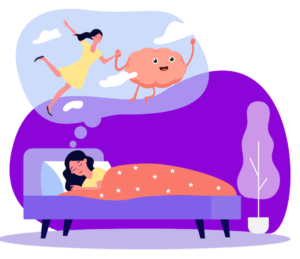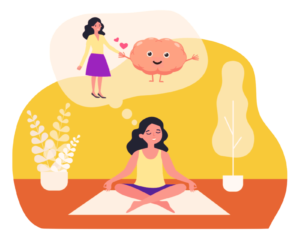In this article, in addition to simply explaining what lucid dreaming is, we dive into the deeper value of dreaming in general. First, we define dreams and a few different ways to think about dreaming. Next, we move on to perception and experience – the mind generates all our experiences whether we’re awake or dreaming. Then, we cover lucidity and dream control. And finally, we discuss why Mindfulness relates to dreams and lucidity.
What are dreams?
To practice dreaming mindfully, we should make sure we understand what dreams actually are! Let’s break it down.
Webster’s dictionary has two definitions of dreams…
Definition of dreams 1:
“A series of thoughts, images or emotions, occurring during sleep.” This definition pertains mostly to Rapid Eye Movement sleep, or REM sleep, during which dreams are the most vivid and detailed … The body’s sensory input is temporarily turned off (sleep paralysis) and the mind creates the entire dream-experience.
Definition of dreams 2:
“An experience of waking life having the characteristics of a dream: such as… An imaginary visualization, OR a state of mind marked by abstraction, OR an object seen in a dreamlike state.”
Now, let’s not take these definitions too literally… We just have to start somewhere. The point I want you to remember is: The second definition of dreams refers to dreaming while awake. We usually think of this as daydreaming. So, daydreaming technically counts as a form of dreaming, and we do this more often than we might realize.
But dreaming while awake is more than just daydreaming; consider that part about ‘abstraction’. That’s when you create a mental framework or mental model, you form a picture in your mind of a situation or concept, etc… that is abstraction. Thinking in the abstract rather than being present and engaging with your immediate surroundings. Visualizing, fantasizing, calculating, conceptualizing, even getting caught up in memories are all forms of mental abstraction. And the point is, technically, they are all different forms of dreaming.
Our experiences are simulations
Not in the sense that we’re trapped in a god-like computer programing system… But at the level of experience, everything we perceive in life is a simulation – a mental model. We cannot perceive clearly without the integrity of a healthy brain. And we do not perceive the outside world as it actually is because the universe is too vast and complex for perception and comprehension.
To illustrate, we can only see within the visible light spectrum; we can’t see infrared or ultraviolet light, yet we know there are more lightwave frequencies in reality. The same goes for sound – there’s an audio spectrum, and humans can only hear sounds within a certain range of that spectrum.
We can only smell what’s close enough to us to smell, while dogs’ sense of smell, for example, is orders of magnitude better than ours. Dogs have around 300 million olfactory receptors in their noses, while humans only have 6 million. And the area of dogs’ brains that analyzes smells is, proportionally, 40x greater than that of humans!
So, our model of the world we live in is not an accurate, one-for-one picture of the world around us. It is only as accurate as our brain and mind can make it given the information it receives from our senses. It’s a matter of objectivity versus subjectivity; we can measure and understand the objective universe, but we will only ever be able to experience it subjectively.
So, if we’re not perceiving reality, what are we perceiving?
Everything we experience in life is our mind’s best guess at what’s happening around us, and what we should do given the circumstances.
When we’re awake, our sense organs work with the brain to create the experiences we have. Reality, as we experience it, is a relationship between our mind and the outside world. The body brings in sensory information, and the mind generates a perceived experience based on that information. This ‘experience’ or simulation is the best the mind can do. And it’s pretty damn good at it, to be honest. But we are not perceiving reality, we are perceiving a simulated version of reality.
Now, this may be difficult to wrap your mind around. It surely does seem like we’re experiencing the real world around us, but it’s easier to accept when you consider the phenomenon of dreaming. See, during REM sleep, the sense organs are not bringing information in, so the brain is generating all the sensory perception on its own. Our eyes are closed, yet we can see imagery. There are no sounds in our bedrooms while we’re sleeping, yet in dreams, we can hear sounds, noises, music, or voices.
The dream-reality simulation is easier to accept as such than the waking-reality simulation… simply because it appears to be self-evident. What other explanation could there be for the multisensory experiences in dreams?
If you’re still not convinced, learn lucid dreaming and try breaking the laws of physics; it will become abundantly clear that you’re in a simulated reality. Any sort of mental-model, any imaginary situation we can conceptualize – they’re all within the realm of possibility in the simulation of the dream state.
And in a more subtle way, we dream while we’re awake so we can re-conceptualize situations in the abstract and mentally re-frame our experiences. We can get creative with our waking life, and that creativity depends upon our ability to dream. This is where lucid dreaming comes in.
What is lucid dreaming?
Lucid Dreaming is defined as explicit clarity of the fact that you are dreaming, during the dream. It is present-moment awareness during rapid eye movement (REM) sleep.
Your mind wakes up, but your body stays asleep – hence the name Mind Awake. Actually, side note here, a good mantra to repeat as you fall asleep at night is “Mind Awake, body asleep, mind awake, body asleep”… repeat that and try to hold onto awareness as you doze off… that might be all you need to get lucid.
Here’s the definition of lucidity:
Lucidity
noun
Lucid dreaming is defined as dreaming with clear and explicit awareness of the fact that one is dreaming.
So, just as we can become aware we’re daydreaming during the day, we can become aware we’re dreaming during sleep. The cool part about lucid dreaming is you can stay in the dream and explore your dream-world consciously, without disrupting sleep… and after some practice, you can change what happens in the lucid dream.
Lucid dreaming is an opportunity to practice very high-resolution abstraction and conceptualization. In the lucid state, we have unlimited creative freedom and a vivid, detailed arena in which to experiment, explore, and discover new ways of thinking and being.
Dream control vs lucidity
A common misconception is that lucid dreaming is the ability to control dreams. But ‘lucidity’ means ‘clarity’, not control… we can have dreams in which we feel in control, yet completely unaware of the fact that it’s a dream.
Example: You could find yourself flying; navigating through the air. You could see an obstacle up ahead and skillfully maneuver around it without crashing.
You can do all this, and you probably have felt in-control during dreams, without realizing you’re dreaming. And thus it wouldn’t count as a lucid dream.
On the other hand, you might become aware you’re dreaming, but have no real sense of control… for example, I became lucid in a dream once. I knew I was dreaming, but it didn’t occur to me that I could change anything, so I just observed what was happening until I woke up.
If you’ve had lucid dreams in the past, you know the dream world can be very unstable – it’s easy to get distracted. And when you get distracted, it’s easy to lose your sense of stability in the lucid state. This is why meditation can be a great supporting exercise.
Why meditating helps with lucid dreaming
 Meditating is essentially guiding and maintaining attention on purpose and focusing on something specific despite potential distractions. You’re still you when you’re dreaming, it’s still your mind… so improving attention span, focus, and concentration while awake will improve those same abilities during lucid dreams. And vice-versa; if you practice maintaining mental stability in dreams, you become more skilled at it in waking life.
Meditating is essentially guiding and maintaining attention on purpose and focusing on something specific despite potential distractions. You’re still you when you’re dreaming, it’s still your mind… so improving attention span, focus, and concentration while awake will improve those same abilities during lucid dreams. And vice-versa; if you practice maintaining mental stability in dreams, you become more skilled at it in waking life.
“The stability and clarity of your dreams is nothing more than the stability and clarity of attention itself.” – Andrew Holocek (Dream Yoga)
Lucid dreaming is a healthy practice
Dreaming is something we do much more often than simply during sleep. Daydreaming counts as dreaming. Just as we can snap out of the daydream and become mindfully aware while awake, we can do the same during dreams while asleep. But just because we can become aware we’re dreaming, doesn’t mean we have automatic control of what happens next in the dream. Dream control takes practice, patience, and discipline – it won’t be easy right away.
The larger implication here is that whether we’re sleeping or awake, our mind generates the experiences we have. Our consciousness, at the level of personal experience, is actually an illusion or simulation. And this is why Mindfulness is so important. The practice teaches us to create the kind of experiences we want to have, within the simulation. It’s about driving rather than being driven.
In the guided course in the app, you get to practice maintaining and prolonging mindfulness during the day and lucidity while asleep at night… and there are also lessons that teach how to manipulate and transform the dream world at will. But it’s not just about lucid dreaming; it’s about lucid living – living the kind of day-to-day life you WANT to live.
So what do you think about all this? Are you able to get lucid? Can you influence the dream or work with the dream once lucid? Share in the comments below and download the app to learn more!

